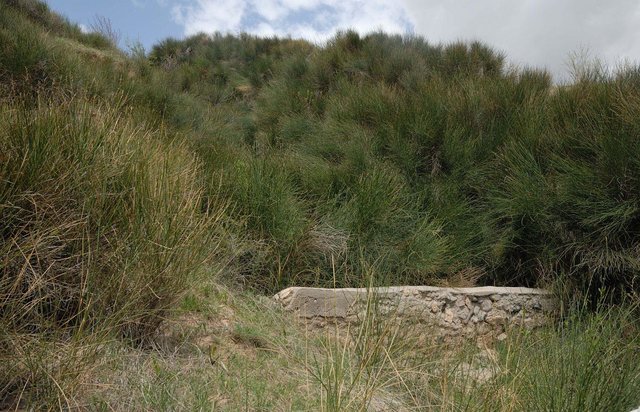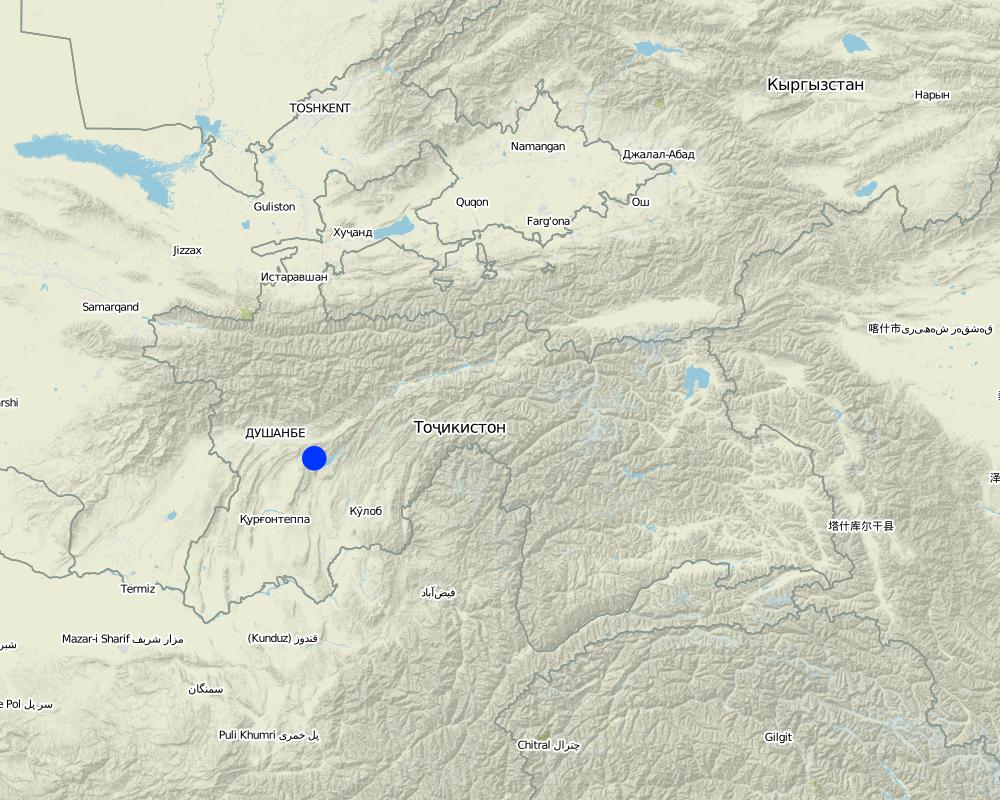Field research station for analysing soil conservation measures [塔吉克斯坦]
- 创建:
- 更新:
- 编制者: Gulniso Nekushoeva
- 编辑者: –
- 审查者: David Streiff
approaches_2573 - 塔吉克斯坦
查看章节
全部展开 全部收起1. 一般信息
1.2 参与方法评估和文件编制的资源人员和机构的联系方式
SLM专业人员:
SLM专业人员:
有助于对方法进行记录/评估的机构名称(如相关)
Tajik Soil Insitute (Tajik Soil Institute) - 塔吉克斯坦有助于对方法进行记录/评估的机构名称(如相关)
CDE Centre for Development and Environment (CDE Centre for Development and Environment) - 瑞士1.3 关于使用通过WOCAT记录的数据的条件
编制者和关键资源人员接受有关使用通过WOCAT记录数据的条件。:
是
1.4 SLM技术问卷的参考

Gully rehabilitation [塔吉克斯坦]
Gullies are stabilized through the establishment of a gabion and the plantation of spanish drok (Spartium junceum L).
- 编制者: Qobiljon Shokirov
2. SLM方法的描述
2.1 该方法的简要说明
Research Station of the Tajik Academy of Agrarian Science, Soil Institute conducting research on soil conservation and productivity in the rainfed hill zones of central Tajikistan.
2.2 该方法的详细说明
该方法的详细说明:
Aims / objectives: The main goal of the research station is the rehabilitation and protection of erosion prone loess areas through monitoring of soil erosion and soil moisture, gully rehabilitation, rehabilitation of degraded pastures through the establishment of a vineyard on terraced land.
Methods: Researchers and students of the department of soil erosion together with the field station manager and several laboratory assistants are conducting field experiments for their research e.g. standardised runoff plots. The demonstration plots are also used in teaching of university students and for project visits.
Stages of implementation: The research station was established in 1968.
Role of stakeholders: The land belonging to the field station was rented out to a group of 5 farmers who are directed by the researchers and have to deliver 50% of the crop yield to the soil institute.
Other important information: During the last years the research station has received additional support from international organisations and programmes such as ICARDA, IAEA-FAO and NCCR North-South for renovating infrastructure (buildings, climate station etc.).
2.5 采用该方法的国家/地区/地点
国家:
塔吉克斯坦
区域/州/省:
RRS
有关地点的进一步说明:
Faizabad, Javonon, Karsang
Map
×2.6 该方法的开始和终止日期
注明开始年份:
1968
2.7 方法的类型
- research
2.8 该方法的主要目的/目标
The Approach focused mainly on SLM with other activities (productivity increase, testing of crop types)
The main goal of the research station is the rehabilitation and protection of erosion prone loess areas through monitoring of soil erosion and soil moisture, gully rehabilitation, rehabilitation of degraded pastures through the establishment of a vineyard on terraced land.
The SLM Approach addressed the following problems: knowledge gaps in agricultural production and soil erosion
2.9 推动或妨碍实施本办法所适用的技术的条件
财务资源和服务的可用性/可得性
- 阻碍
lack of finances to conduct research
Treatment through the SLM Approach: mobilization of government funding
机构设置
- 阻碍
technical experts were not available
Treatment through the SLM Approach: capacity building of institutional human potential
法律框架(土地使用权、土地和水使用权)
- 启动
The existing land ownership, land use rights / water rights greatly helped the approach implementation: state ownership of land facilitated the establishment of the research station
- 阻碍
legal status unclear
Treatment through the SLM Approach: new law that the land of the research station can not be given away as certificate
了解SLM,获得技术支持
- 阻碍
lack of technical equipment
Treatment through the SLM Approach: provided by government and rented by land users
其他
- 阻碍
limited agricultural knowledge
Treatment through the SLM Approach: pilot projects, disseminate knowledge through trainings and seminars
3. 相关利益相关者的参与和角色
3.1 该方法涉及的利益相关者及其职责
- 当地土地使用者/当地社区
- SLM专家/农业顾问
- 地方政府
- 国家政府(规划者、决策者)
- Academy of Aicultural Sciences
3.2 当地土地使用者/当地社区参与该方法的不同阶段
| 当地土地使用者/当地社区的参与 | 指定参与人员并描述活动 | |
|---|---|---|
| 启动/动机 | 无 | |
| 计划 | 无 | |
| 实施 | 外部支持 | |
| 监测/评估 | 互动 | |
| Research | 无 |
3.4 有关SLM技术选择的决策
具体说明谁有权决定选择要实施的技术:
- 主要是SLM专家,咨询土地使用者之后
解释:
During Soviet times it was a a top-down government approach to adress knowledge gaps through research. In recent times the farmers have repeatedly taken initiative to tackle problems by writing letters to the institute. IN the end it is the institute that takes the final decisions.
Decisions on the method of implementing the SLM Technology were made by mainly by SLM specialists with consultation of land users
4. 技术支持、能力建设和知识管理
4.1 能力建设/培训
是否为土地使用者/其他利益相关者提供培训?:
是
明确受训人员:
- 土地使用者
- university students
如果相关,请说明性别、年龄、地位、种族等。:
land users who are employed at the research station
培训形式:
- 在职
- 示范区域
- 课程
涵盖的主题:
soil erosion, agricultural productivity
4.2 咨询服务
土地使用者有权使用咨询服务吗?:
是
说明/注释:
Advisory service is inadequate to ensure the continuation of land conservation activities; lack of finances to conduct new research
4.3 机构强化(组织发展)
是否通过这种方法建立或加强了机构?:
- 否
4.4 监测和评估
监测和评估是该方法的一部分吗?:
是
注释:
bio-physical aspects were regular monitored by government through measurements; indicators: soil moisture, soil loss, runoff, soil fertility properties, climate indicators
technical aspects were regular monitored by government through measurements; indicators: different crop rotations
economic / production aspects were regular monitored by government through measurements; indicators: yields
There were several changes in the Technology as a result of monitoring and evaluation: different crop rotation schemes, mulching of vineyards, adaptation of fertilizer amount applied
4.5 研究
研究是该方法的一部分吗?
是
明确话题:
- 技术
提供进一步的细节,并指出是谁做的研究:
researchers from the soil institute conducting research on soil erosion and agricultural productivity, university students conducting mainly Phd and Postdoc research
Research was carried out on station
5. 融资和外部物质支持
5.1 该方法中SLM组成部分的年度预算
注释(例如主要的资助来源/主要捐助者):
Approach costs were met by the following donors: government: 100.0%
5.2 为土地使用者提供财政/物质支援
土地使用者是否获得实施该技术的财政/物质支持?:
是
如果是,请具体说明支持的类型、条件和提供者:
Fully financed by the government through the Academy of Science
5.3 对特定投入的补贴(包括劳动力)
- 设备
| 具体说明哪些投入得到了补贴 | 程度如何 | 对补贴做出具体说明 |
|---|---|---|
| 工具 | 充分融资 | |
| climate station | 充分融资 | |
- 农业
| 具体说明哪些投入得到了补贴 | 程度如何 | 对补贴做出具体说明 |
|---|---|---|
| 种子 | 充分融资 | |
| 化肥 | 充分融资 | |
| seedlings | ||
- 建筑
| 具体说明哪些投入得到了补贴 | 程度如何 | 对补贴做出具体说明 |
|---|---|---|
| 石料 | 充分融资 | |
| 木材 | 充分融资 | |
- 基建
| 具体说明哪些投入得到了补贴 | 程度如何 | 对补贴做出具体说明 |
|---|---|---|
| 道路 | 充分融资 | |
| soil laboratory | 充分融资 | |
如果土地使用者的劳动力是一项重要的投入,那么是不是:
- 获得其他物质支持
注释:
Labour is paid in cash as well
50% of the yield belongs to the land users
5.4 信用
是否根据SLM活动的方法给予信用值?:
否
5.5 其它激励或手段
是否有其他激励措施或工具用于促进SLM技术的实施?:
否
6. 影响分析和结论性陈述
6.1 方法的影响
该方法是否帮助土地使用者实施和维护SLM技术?:
- 否
- 是,很少
- 是,中等
- 是,支持力度很大
During Soviet times recommendations for the land committee were elaborated based on results from the research station, nowadays these mechanisms are not in place anymore and knowledge dissemination to land users is hardly taking place.
该方法是否有助于社会和经济弱势群体?:
- 否
- 是,很少
- 是,中等
- 是,支持力度很大
该方法是否改善了阻碍SLM技术实施的土地使用权/用户权问题?:
- 否
- 是,很少
- 是,中等
- 是,支持力度很大
before, land was under common use and therefore no conservation activities were implemented
Did the Approach help to alleviate poverty?
- 否
- 是,很少
- 是,中等
- 是,支持力度很大
6.2 土地使用者实施SLM的主要动机
- 支付/补贴
- 规章制度(罚款)/执行
top-down enforcement
- 声望、社会压力/社会凝聚
6.3 方法活动的可持续性
土地使用者能否维持通过该方法实施的措施(无外部支持的情况下)?:
- 是
若是,请说明如何维持:
farmers continue with maintenance activities
6.4 该方法的长处/优点
| 土地使用者眼中的长处/优势/机会 |
|---|
| Access to new technologies for farmers working on the research station (How to sustain/ enhance this strength: ensure ongoing research activities) |
| Capacity building for PhD and Postdoc students |
| 编制者或其他关键资源人员认为的长处/优势/机会 |
|---|
| Specific knowledge gaps can be adressed with field experiments (How to sustain/ enhance this strength: ensure ongoing financial support for research activities from diverse sources such as government, international organisations or through provision of services) |
| Enables longterm research and monitoring (How to sustain/ enhance this strength: continued government ownership and support) |
6.5 该方法的弱点/缺点以及克服它们的方法
| 编制者或其他关键资源人员认为的弱点/缺点/风险 | 如何克服它们? |
|---|---|
| On-station approach might not reflect the situation of local farmers | using the research station as a base for conducting research on land of surrounding villages |
| Nowadays there are no efforts to disseminate the knowledge among local farmers in Tajikistan | establishment of advisory services, training courses, farmer schools |
| Since the early 90ies the involvement of university students has strongly decreased due to lack of financial resources | facilitating fieldwork and internships through the Soil Institute and the Tajik Agrarian University |
7. 参考和链接
7.1 方法/信息来源
- 实地考察、实地调查
- 与土地使用者的访谈
链接和模块
全部展开 全部收起链接

Gully rehabilitation [塔吉克斯坦]
Gullies are stabilized through the establishment of a gabion and the plantation of spanish drok (Spartium junceum L).
- 编制者: Qobiljon Shokirov
模块
无模块


